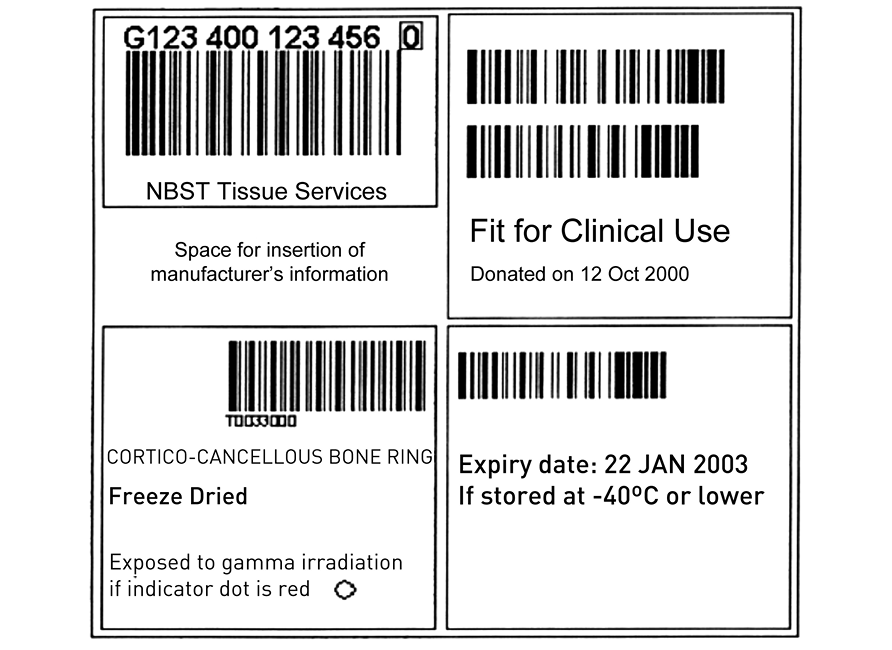24.3: General requirements
24.3.1: Label quality
Labels used for tissue and sample labelling must be:
- self-adhesive using a non-invasive adhesive
- tamper-evident (i.e. removal must deface the label)
- smear-resistant and non-fading
- resistant to water and humidity
- capable of being affixed readily to paper or other base label material, plastic surfaces, glass (particularly glass tubes of 12 mm diameter) without winging (‘winging’ is defined as the lifting of a label from the surface to which it is applied). Winging should not exceed 2.5 mm as the maximum linear distance of the label not adhering to the tube at any label edge, measured after 24 hours of refrigeration at 4°C
- capable of withstanding a temperature range of –80°C to +56°C after application to the tissue container. This range may be extended by the ordering authority at the time of order. This condition must extend to the printed text which must not deteriorate due to thermal conditions. Where products are stored at lower temperatures, labels will be sealed into plastic pockets on the container
- capable of being applied without slippage to tubes etc. subject to temperature variation prior to use, for example tubes/packs stored in a vehicle and then used at normal ambient temperature, such equipment being by definition ‘damp’
- non-flaking when read using a hand-held light-pen touching the label.

Figure 24.1 Label positioning: option 1 (example; see cautionary note in text)

Figure 24.2 Label positioning: option 2 (example; not to scale)
24.3.2: Printing requirements: eye-readable information
The ICCBBA ISBT 128 Technical Specification (latest version can be downloaded from the ICCBBA website www.iccbba.org) stipulates that ‘Every bar code, with the exception of the donation identification number (ICCBBA Data Structure 001), should be accompanied by an exact eye-readable representation of the data characters in the bar code’. In the UK this requirement is not being implemented for the short form unit identifier, and is currently optional for the blood group/status code and expiry date code.
Requirements for each type of label are defined in the appropriate sections.
24.3.3: Printing requirements for barcodes
All barcodes will be printed as specified in the ICCBBA ISBT 128 Technical Specification.
24.3.4: Concatenation
Concatenation for the purpose of this requirement is defined as:
The reading of two horizontally adjacent barcodes together as a single input using a barcode-scanning device.
Concatenation requirements for ISBT 128 are laid out in the ICCBBA ISBT 128 Technical Specification and further expanded in ICCBBA Technical Bulletin No. 5. Where concatenated codes are to be read it is essential that the barcode readers used support concatenation of Code 128 barcodes with the defined temporal/spatial limitations of ISBT 128.
In the UK release status labelling will be confirmed by concatenation of the donation identification number (ICCBBA Data Structure 001) with the non-ICCBBA defined unit identifier (nationally defined – see section 24.3.5) and donation ID. The relevant data identifiers are specified within the appropriate sections of this document. For further details refer to the ICCBBA ISBT 128 Technical Specification (www.iccbba.org).
24.3.5: National ISBT 128 definitions
National bodies are permitted by ICCBBA to allocate nationally defined codes identified by data identifiers of ‘&’ followed by a lower-case alpha character. Within the UK this responsibility lies with SACIT (Standing Advisory Committee on Information Technology).
The following national codes have been assigned by SACIT which will be applied in tissue labelling.
Short form donation identification number (Version 1)
&a
Defined for the shortened form of a donation number used on demand-printed status labels for concatenated read with the donation number as part of label verification. This code must not be used for any other purpose. The code structure is:
&annnnnn
Where:
| &a | are the ISBT 128 data identifiers |
| nnnnnn | is the six-digit unit serial number from the ISBT 128 donation number definition (ICCBBA Data Structure 001). |
Short form donation identification number (Version 2)
&b
Defined for the shortened form of a donation number used on demand-printed status labels for concatenated read with the donation number as part of label verification. This code must not be used for any other purpose. The code structure is:
&bnnnnnnk
Where:
| &b | are the data identifiers |
| nnnnnn | is the six-digit unit serial number from the ISBT 128 donation number definition |
| k | is a single-digit iteration number, used to assist in controlling labelling where more than one labelling process takes place (e.g. an additional group label has to be placed over the initial label to display additional testing information such as CMV (cytomegalovirus) status). |